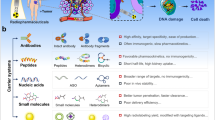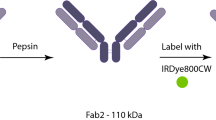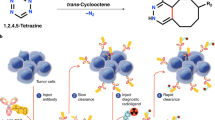Abstract
Here we describe molecular imaging of cancer using signal amplification of a radiotracer in situ by pretargeting a multivalent, bispecific antibody to carcinoembryonic antigen (CEA), which subsequently also captures a radioactive hapten-peptide. Human colon cancer xenografts as small as ∼0.15 g were disclosed in nude mice within 1 h of giving the radiotracer, with tumor/blood ratios increased by ≥40-fold (∼10:1 at 1 h, ∼100:1 at 24 h), compared to a 99mTc-labeled CEA-specific F(ab′) used clinically for colorectal cancer detection, while also increasing tumor uptake tenfold (∼20% injected dose/g) under optimal conditions. This technology could be adapted to other antibodies and imaging modalities.
This is a preview of subscription content, access via your institution
Access options
Subscribe to this journal
Receive 12 print issues and online access
$209.00 per year
only $17.42 per issue
Buy this article
- Purchase on Springer Link
- Instant access to full article PDF
Prices may be subject to local taxes which are calculated during checkout




Similar content being viewed by others
References
Goldenberg, D.M. et al. Use of radiolabeled antibodies to carcinoembryonic antigen for the detection and localization of diverse cancers by external photoscanning. N. Engl. J. Med. 298, 1384–1386 (1978).
Goldenberg, D.M. & Larson, S.M. Radioimmunodetection in cancer identification. J. Nucl. Med. 33, 803–814 (1992).
Delaloye, B. et al. Detection of colorectal carcinoma by emission-computerized tomography after injection of 123I-labeled Fab or F(ab')2 fragments from monoclonal anti-carcinoembryonic antigen antibodies. J. Clin. Invest. 77, 301–311 (1986).
Goldenberg, D.M. Cancer imaging with CEA antibodies: historical and current perspectives. Int. J. Biol. Markers 7, 183–188 (1992).
Halpern, S.E. et al. Scintigraphy with In-111-labeled monoclonal antitumor antibodies: kinetics, biodistribution, and tumor detection. Radiology 168, 529–536 (1988).
Hansen, H.J. et al. Preclinical evaluation of an “instant” 99mTc-labeling kit for antibody imaging. Cancer Res. 50, 794s–798s (1990).
Kasina, S. et al. Simplified preformed chelate protein radiolabeling with technetium-99m mercaptoacetamidoadipoylglycylglycine (N3S-adipate). Bioconjug. Chem. 9, 108–117 (1998).
Larson, S.M. et al. PET scanning of iodine-124–3F9 as an approach to tumor dosimetry during treatment planning for radioimmunotherapy in a child with neuroblastoma. J. Nucl. Med. 33, 2020–2023 (1992).
Kenanova, V. et al. Tailoring the pharmacokinetics and positron emission tomography imaging properties of anti-carcinoembryonic antigen single-chain Fv-Fc antibody fragments. Cancer Res. 65, 622–631 (2005).
Robinson, M.K. et al. Quantitative immuno-positron emission tomography imaging of HER2-positive tumor xenografts with an iodine-124 labeled anti-HER2 diabody. Cancer Res. 65, 1471–1478 (2005).
Revets, H., De Baetselier, P. & Muyldermans, S. Nanobodies as novel agents for cancer therapy. Expert Opin. Biol. Ther. 5, 111–124 (2005).
Goel, A. et al. 99mTc-labeled divalent and tetravalent CC49 single-chain Fv's: novel imaging agents for rapid in vivo localization of human colon carcinoma. J. Nucl. Med. 42, 1519–1527 (2001).
Wong, J.Y. et al. Pilot trial evaluating an 123I-labeled 80-kilodalton engineered anticarcinoembryonic antigen antibody fragment (cT84.66 minibody) in patients with colorectal cancer. Clin. Cancer Res. 10, 5014–5021 (2004).
Yazaki, P.J. et al. Tumor targeting of radiometal labeled anti-CEA recombinant T84.66 diabody and t84.66 minibody: comparison to radioiodinated fragments. Bioconjug. Chem. 12, 220–228 (2001).
Chang, C.-H. et al. Molecular advances in pretargeting radioimmunotherapy with bispecific antibodies. Mol. Cancer Ther. 1, 553–563 (2002).
Boerman, O.C., van Schaijk, F.G., Oyen, W.J. & Corstens, F.H. Pretargeted radioimmunotherapy of cancer: progress step by step. J. Nucl. Med. 44, 400–411 (2003).
Breitz, H.B. et al. Clinical optimization of pretargeted radioimmunotherapy with antibody-streptavidin conjugate and 90Y-DOTA-biotin. J. Nucl. Med. 41, 131–140 (2000).
Forero, A. et al. Phase 1 trial of a novel anti-CD20 fusion protein in pretargeted radioimmunotherapy for B-cell non-Hodgkin lymphoma. Blood 104, 227–236 (2004).
Rossi, E.A. et al. Development of new multivalent-bispecific agents for pretargeting tumor localization and therapy. Clin. Cancer Res. 9, 3886S–3896S (2003).
Rossi, E.A. et al. Pretargeting of CEA-expressing cancers with a trivalent bispecific fusion protein produced in myeloma cells. Clin Cancer Res. 11, 7109s–7121s (2005).
Sharkey, R.M. et al. A universal pretargeting system for cancer detection and therapy using bispecific antibody. Cancer Res. 63, 354–363 (2003).
Moffat, F.L., Jr . et al. Clinical utility of external immunoscintigraphy with the IMMU-4 technetium-99m Fab' antibody fragment in patients undergoing surgery for carcinoma of the colon and rectum: results of a pivotal, phase III trial. The Immunomedics Study Group. J. Clin. Oncol. 14, 2295–2305 (1996).
Le Doussal, J.M., Martin, M., Gautherot, E., Delaage, M. & Barbet, J. In vitro and in vivo targeting of radiolabeled monovalent and divalent haptens with dual specificity monoclonal antibody conjugates: enhanced divalent hapten affinity for cell-bound antibody conjugate. J. Nucl. Med. 30, 1358–1366 (1989).
Goldenberg, D.M. & Hansen, H.J. Carcinoembryonic antigen present in human colonic neoplasms serially propagated in hamsters. Science 175, 1117–1118 (1972).
Sharkey, R.M. et al. Optimizing bispecific antibody pretargeting for use in radioimmunotherapy. Clin. Cancer Res. 9, 3897S–3913S (2003).
U.S. Food and Drug Administration. Guidance for Industry and Reviewers: Estimating the Safe Starting Dose in Clinical Trials for Therapeutics in Adult Healthy Volunteers (CDER/CBER draft guidance, Dec 2002 www.fda.gov/cder/guidance/3814dft.pdf).
Lewis, M.R. et al. In vivo evaluation of pretargeted 64Cu for tumor imaging and therapy. J. Nucl. Med. 44, 1284–1292 (2003).
Goldenberg, D.M. Perspectives on oncologic imaging with radiolabeled antibodies. Cancer 80, 2431–2435 (1997).
Griffiths, G.L. et al. Reagents and methods for PET using bispecific antibody pretargeting and 68Ga-radiolabeled bivalent hapten-peptide-chelate conjugates. J. Nucl. Med. 45, 30–39 (2004).
Waldmann, T.A. Immunotherapy: past, present, and future. Nat. Med. 9, 269–277 (2003).
Losman, M.J., Novick, K.E., Goldenberg, D.M. & Monestier, M. Mimicry of a carcinoembryonic antigen epitope by a rat monoclonal anti-idiotype antibody. Int. J. Cancer 56, 580–584 (1994).
McConahey, P.J. & Dixon, F.J. A method of trace iodination of proteins for immunologic studies. Int. Arch. Allergy Appl. Immunol. 29, 185–189 (1966).
Acknowledgements
We thank D. Yeldell, L. Osorio and P.-Y. Brard for their assistance with the animal studies, and N. Velasco for the radiolabeling and quality assurance performed on the reagents used. This work was supported in part by US Public Health Service grant EB002114 from the National Institute of Biomedical Imaging and Bioengineering, US National Institutes of Health, and grant 05-1842-FS-N-0 from the New Jersey Department of Health and Senior Services.
Author information
Authors and Affiliations
Corresponding author
Ethics declarations
Competing interests
David M. Goldenberg, Chien-Hsing Chang and Edmund A. Rossi have stock interest or other salary support from IBC Pharmaceuticals, Inc.. David M. Goldenberg, Thomas M. Cardillo, Edmund A. Rossi, Chien-Hsing Chang, William J. McBride, Hans J. Hansen and Ivan D. Horak have stock interest or other salary support from Immunomedics, Inc..
Supplementary information
Supplementary Fig. 1
Quantification of radiotracer uptake during dynamic imaging. (PDF 210 kb)
Supplementary Fig. 2
Emailed author 10/5/05 (PDF 146 kb)
Supplementary Fig. 3
SDS-PAGE analysis of three batches of hBS14 following single-step purification with Affigel-IMP-291 affinity chromatography. (PDF 94 kb)
Supplementary Fig. 4
BIAcore sensorgram showing simultaneous HSG and CEA binding for hBS14 multivalent bsMAb, confirming dual specificity of the bsMAb. (PDF 30 kb)
Supplementary Fig. 5
99mTc-IMP-245 bivalent HSG peptid used as the radiotracer for these studies. (PDF 97 kb)
Supplementary Table 1
The effect of adjusting the bsMAb doe and interval on the uptake of 99mTc radiotracer in the tumor and blood. (PDF 14 kb)
Supplementary Table 2
Biodistribution of 99mTc radiotracer in nude mice bearing GW-39 tumors that were given 500 pmol of the di-bsMAb followed 24 h later with 50 pmol (32 μCi) of the 99mTc radiotracer. (PDF 16 kb)
Supplementary Movie 1
Dynamic 2-min images showing the uptake and elimination of each 99mTc agent over 60 min. (MOV 12376 kb)
Rights and permissions
About this article
Cite this article
Sharkey, R., Cardillo, T., Rossi, E. et al. Signal amplification in molecular imaging by pretargeting a multivalent, bispecific antibody. Nat Med 11, 1250–1255 (2005). https://doi.org/10.1038/nm1322
Received:
Accepted:
Published:
Issue Date:
DOI: https://doi.org/10.1038/nm1322
This article is cited by
-
Radiochemistry for positron emission tomography
Nature Communications (2023)
-
Recent advances of bispecific antibodies in solid tumors
Journal of Hematology & Oncology (2017)
-
SPECT/NIRF Dual Modality Imaging for Detection of Intraperitoneal Colon Tumor with an Avidin/Biotin Pretargeting System
Scientific Reports (2016)
-
Predictive patient-specific dosimetry and individualized dosing of pretargeted radioimmunotherapy in patients with advanced colorectal cancer
European Journal of Nuclear Medicine and Molecular Imaging (2014)
-
Radiofluorination using aluminum-fluoride (Al18F)
EJNMMI Research (2013)



